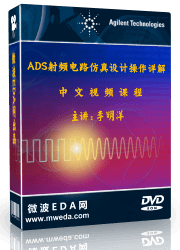- 易迪拓培训,专注于微波、射频、天线设计工程师的培养
MMIC design (ADS2014+proprietaryPDK+EMPro2013)
I'm doing a Ph.D in MMIC design for uW frequencies and I'm new to ADS and EMPro, though I have experience with MWOffice and CST, so I'm familiar with EM simulations.
I'm trying to export an ADS PA MMIC design (with a proprietary PDK) to EMPRo, and simulate it with the FEM and FDTD engines. For that purpose, first and rather than exporting the whole project I just export a via and a microstrip line, using the export button in the EM Setup(FEM). When I check the exported geometry in EMPro, I see that the various substrate layers (dielectrics, resistance sheets, metals...) of my PDK are correctly stacked up, but there where two or more solids coexist, neither material volume is voided to place any other solids E.g.:
Vertical via metal through several substrate layers: Substrate layers remain continuous, with no "punching holes" where via should exist, in a given location, both via solid and dielectric layers solids coexist.
My first question is whether I have to manually fix this, or if there is any mechanism (kind of material precedence setting, like in the PDK) to overcome this type of issues. This is also applicable to the case when an upper air layer is placed above a circuit. Do I have tofirst define a PEC sheet in the dielectric-air interface and then extrude it(Hoping the extrusion process voids "air volume" to accomodate the metallic extrusion)?
And secondly, Do waveguide ports (modal or nodal) have to be located in the boundaries of the simulation box? Can they be located inside the simulation domain? In case a waveguide port is located inside the simulation domain, does it excite modes in the two directions prependicular to its defined surface?
Thanks in advance, regards.
Iban
Simple question: why use the EMPro framework and not the FEM engine directly from within ADS? That would a much nicer workflow, with almost identical FEM capabilities.
I would expect that FEM is the 3D solver method of choice anyway, and there is no need/advantage to use FDTD for this application.
Correct. This is solved by different priorities that are assigned to materials. This is a nice concept used by some 3D solvers, nice because there is no need for boolean operations in overlapping volumes.
All 3D solvers that I know use waveguide ports only on the boundary of the simulation volume. Inside the simulation volume, lumped ports are used. This is also true for EMPro (lumped sheet port, calibrated or uncalibrated).
Hi volker, thanks for your instant reply!
I thought that EMPro being a specific microwave design tool would incorporate a somehow improved FEM engine compared to ADS, that's why I started to use it, but if the FEM engines are almost the same, I'll give a chance to ADS's FEM also.
Maybe its a false sense of "control" that GUI gives me over the design aspects, like those of overlapping solids...
As for the itme solver, I wanted to use the FDTD engine to evaluate the acquisition of a GPU unit for our simulation PC, in order to see if the performance improvement of FDTD+GPU over FEM was worth the money.
Does ADS's FEM follow this same precedence scheme? If so, I understand from your answer that it's only a matter of setting these precedences correctly in the PDK, before EM simulation.
So... can't I set a waveguide port in la line inside the structure and excite it with different modes to measure the coupling of these different modes in my other ports?
By the way, I've read several posts of yours in this forum as well as downloaded appnotes from your webpage so i have to thank you for helping people like me make our way in the microwaves!
Regards
Iban
Iban, the same FEM engine is used in ADS and EMPro. There might be some differences in release dates, so that ADS is some months back, but overall: same engine. The only difference is the user interface: the ADS layout editor allows to extrude 3D objects from 2D layout, which includes some rather tricky stuff
http://muehlhaus.com/support/ads-app...3d-passivation
But for general 3D drawing, the EMPro solid modelling editor has more capabilities. If needed, I would draw only the complex 3D object in EMPro and then bring this 3D block into ADS (not the other way). But for your on-chip EM, I think the ADS layout is all you need.
I see. From my own experience with FDTD and FEM, I would rather use FEM for this type of circuit: electrically small with many complex layout details, and typically many ports. But give it a try and see how it works for your designs/models.
Yes and yes.
No, and I don't think that any other 3D solver allows wave ports inside the model. The usual method is to use lumped ports and excite/terminate a specific mode. This works well.
You are welcome, Iban, thanks for the friendly feedback! I started my EM support work for Sonnet EM more than 15 years ago, and have seen many EM tools, models and applications since then. So much can be done with EM - and so much can be done wrong if the user isn't trained/supported well ... From forums questions I can learn where typical issues/mistakes/misunderstandings are, which helps me to better train/support my clients.
申明:网友回复良莠不齐,仅供参考。如需专业帮助,请学习易迪拓培训专家讲授的ADS视频培训课程。
上一篇:sos for ADS materials
下一篇:Not a project directory in ADS...
ADS婵炴垶鎼╅崢浠嬪几閸愵亝鍠嗛柛鈩冧緱閺嗐儵鏌涢埡鍐炬敯妞ゆ柨瀚板顐⑩枎閹存梹鐓� | More...
 国内最全面、最专业的Agilent ADS培训课程,可以帮助您从零开始,全面系统学习ADS设计应用【More..】
国内最全面、最专业的Agilent ADS培训课程,可以帮助您从零开始,全面系统学习ADS设计应用【More..】
- Agilent ADS教学培训课程套装
- 两周学会ADS2011、ADS2013视频教程
- ADS2012、ADS2013射频电路设计详解
- ADS高低阻抗线微带滤波器设计培训教程
- ADS混频器仿真分析实例视频培训课程
- ADS Momentum电磁仿真设计视频课程
- ADS射频电路与通信系统设计高级培训
- ADS Layout和电磁仿真设计培训视频
- ADS Workspace and Simulators Training Course
- ADS Circuit Simulation Training Course
- ADS Layout and EM Simulation Training Course
- Agilent ADS 内部原版培训教材合集








